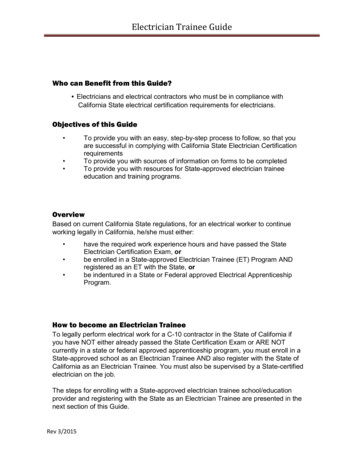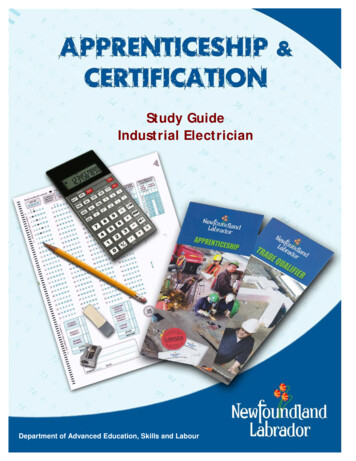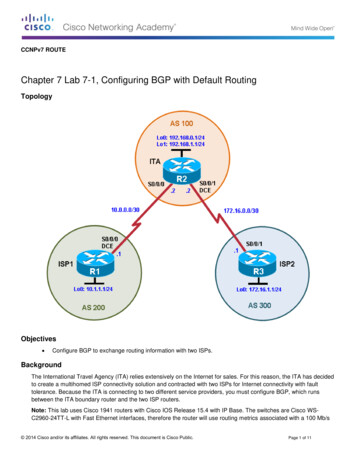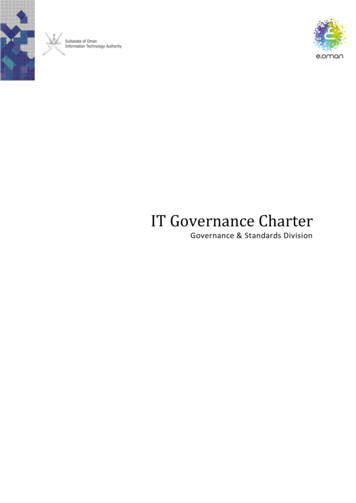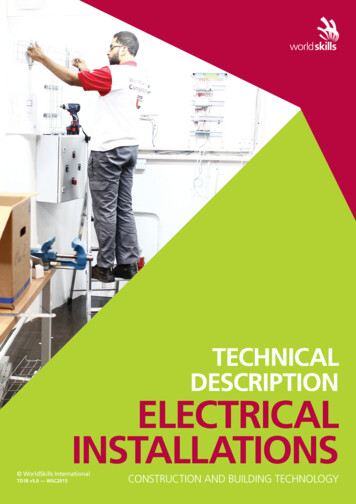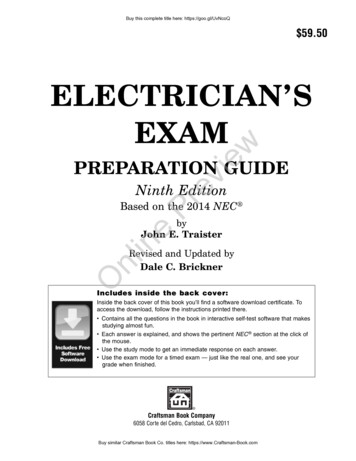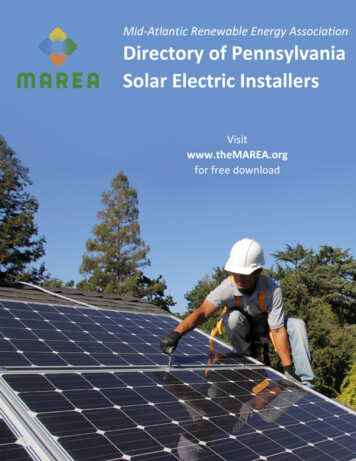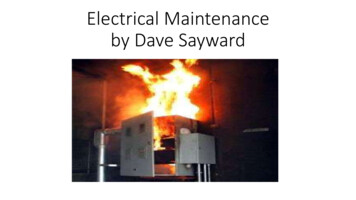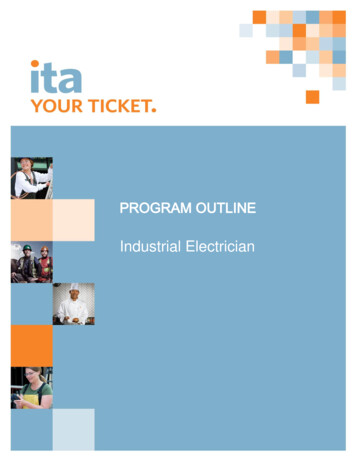
Transcription
Industrial Electrician
The latest version of this document is available in PDF format on the ITA websitewww.itabc.caTo order printed copies of Program Outlinesor learning resources (where available)for BC trades contact:Crown Publications, Queen’s PrinterWeb: www.crownpub.bc.caEmail: crownpub@gov.bc.caToll Free 1 800 663-6105Copyright 2011 Industry Training AuthorityThis publication may not be modified in any way without permission of the Industry Training AuthorityIndustrial Electrician03/16Industry Training Authority1
INDUSTRIAL ELECTRICIANPROGRAM OUTLINEAPPROVEDFEBRUARY 2012BASED ONNOA 2008Developed byIndustry Training AuthorityProvince of British ColumbiaIndustrial Electrician03/16Industry Training Authority1
TABLE OF CONTENTSSection 1 INTRODUCTION. 1Foreword . 2Acknowledgements . 3How to Use this Document . 4Understanding Competency Standards . 6Section 2 PROGRAM OVERVIEW . 7Program Credentialing Model . 8Program Assessment . 9Occupational Analysis Chart . 11Training Topics and Suggested Time Allocation . 16Workplace Competencies . 19Section 3 PROGRAM CONTENT . 23Technical TrainingLevel 3 . 24Level 4 . 51Workplace CompulsoryLevel 1 and Level 2 . 79Level 3 . 92Level 4 . 109Workplace ElectivesElective Competencies . 129Section 4 TRAINING PROVIDER STANDARDS . 192Facility Requirements . 193Tools and Equipment . 194Reference Materials . 196Print and On-Line Reference Materials . 197Instructor Requirements . 200Section 5 ASSESSOR REQUIREMENTS . 201Workplace Assessors . 202Industrial Electrician03/16Industry Training Authority2
IntroductionSection 1INTRODUCTIONIndustrial ElectricianIndustrial Electrician03/16Industry Training Authority1
IntroductionForewordIndustrial Electricians install and maintain the electrical fixed assets of industrial operations.Operations which are likely to employ Industrial Electricians are: Oil and gas processing plants Mining and smelting operations Food processing plants Sawmills Manufactured wood product plants Printing plants Pulp and paper mills Light and heavy manufacturing operations Industrial Construction Contract Operations Water and sewage treatment plants Other utility installationsIndustrial Electricians are relied upon to troubleshoot and diagnose electrical and process failures inmanufacturing and processing facilities. Troubleshooting requires a broad base of electrical competencein order to isolate and repair faults and failures. When a plant or process is down, time is of the essencein finding and repairing faults, but speed must not come at the expense of safety.As almost all plant processes and equipment are electrically energized the Industrial Electrician is likelyto be involved in all aspects of an operation, often working with Millwrights, process operators andInstrument Mechanics to troubleshoot equipment and optimize processes.Industrial Electricians are competent working at extra low, low and high voltages and can be called on toinstall lighting right through to installation of high voltage transformers. They are able to build and installelectrical systems, although the amount of time spent doing this varies widely between place soemployment.Electrical technology and equipment changes rapidly. Industrial Electricians are required to continuallylearn and develop new skills to keep current with new technology and processes.Industrial Electricians can move into maintenance planning and other supervisory positions as well asdevelop specialized skills in areas of the trade beyond the apprenticeship program.SAFETY ADVISORYBe advised that references to the WorkSafeBC safety regulations contained within these materials donot/may not reflect the most recent Occupational Health and Safety Regulation (the currentStandards and Regulation in BC can be obtained on the following website:http://www.worksafebc.com). Please note that it is always the responsibility of any person usingthese materials to inform him/herself about the Occupational Health and Safety Regulation pertainingto his/her work.Industrial Electrician03/16Industry Training Authority2
IntroductionAcknowledgementsThis Program Outline was prepared with the advice and direction of an industry steering committee, ledby the Resource Training Organization (RTO). The Resource Training Organization (RTO) assumedresponsibility for the development and maintenance of the Industrial Electrician apprenticeship trainingprogram in 2007.This Program Outline is based on the 2007 Industrial Electrician Competency Standards. Development ofthe competency standards was led by HITAC/Labour Industrial Electrical Apprenticeship DevelopmentCommittee. The competency standards were developed through extensive consultation with a broadcross-section of stakeholders in BC’s heavy industry sectors – mining and smelting, oil and gas, pulp andpaper and solid wood processing. The program received extensive support by industry, unions and bothFederal government and Provincial government agencies.Industry Subject Matter Experts (SMEs) retained to assist in the development of Program Outline content.PHASE 1 – 2005PHASE 2 – 2006 – 2007 Stuart Blundell, Canfor Pulp TrustAinsley Encinas, AlcanBruce Reeds, Highland Valley CopperAl Stewart, Spectra EnergyBrent Masuch, Terasen GasCarl Thesen, TolkoKevin Zornes, WeyerhaeuserBernie Radfux, Western Forest ProductsRichard Wittman, Eurocan Pulp and PaperKarl Luszszak, Pope & TalbotBuff Wilkinson, Elk Valley CoalRoss Turvey, DomtarFrank Gervais, Terasen GasDuncan Gable, Catalyst PaperAinsley Encinas, Alcan Inc.Paul Sinclair, Elk Valley CoalBruce Reeds, Highland Valley CopperAlan Stewart, Spectra EnergyErnst Pfanner, Spectra EnergyBrent Masuch, Terasen GasStuart Blundell, CanforRichard Wittman, Eurocan Pulp & PaperDave Lord, Catalyst PaperKarl Luszszak, Pope & Talbot Pulp & PaperArt Foote, West FraserCarl Thesen, TolkoKevin Zornes, WeyerhaeuserThe Industrial Electrical Training Provider Consortium, a group of four colleges, supported developmentof the Theory Competency Standards and the integration of those standards into the overall Qualification. Thompson Rivers University, Ralph Finch, DeanNorth Island College, Don Gillingham, DeanCollege of New Caledonia, Jan Jonkers, DeanCollege of the Rockies, Ron McRae, DeanThe Instructor SMEs who participated in development of these competency standards are: Peter Poeschek, Thompson Rivers University Andrew Marr, North Island CollegeSteven Campbell, College of New CaledoniaIan Goring, College of the RockiesProgram revised in 2011Construction Electrician Level 1 and Level 2 were approved as common core for the Industrial Electricianprogram. This Program Outline and Occupational Analysis Chart have been revised to reflect thischange.The Industry Training Authority would like to acknowledge the dedication and hard work of all the industryrepresentatives appointed to identify the training requirements of the Industrial Electrician occupation.Industrial Electrician03/16Industry Training Authority3
IntroductionHow to Use this DocumentThis Program Outline has been developed for the use of individuals from several different audiences.The table below describes how each section can be used by each intended audience.SectionTraining am length andstructure, and allpathways sUnderstand the lengthand structure of theprogramUnderstand the lengthand structure of theprogram, and pathwayto completionUnderstandchallenger pathway toCertificate ofQualificationCommunicateprogram completionrequirements andassessment methodsUnderstand thevarious assessmentrequirements for theprogramUnderstand thevarious assessmentrequirements for theprogramUnderstand theassessmentrequirements theywould have to fulfill inorder to challenge theprogramOACCommunicate thecompetencies thatindustry has definedas representing thescope of theoccupationUnderstand thecompetencies that anapprentice is expectedto demonstrate inorder to achievecertificationView thecompetencies they willachieve as a result ofprogram completionUnderstand thecompetencies theymust demonstrate inorder to challenge theprogramTrainingTopics andSuggestedTimeAllocationShows proportionaterepresentation ofgeneral areas ofcompetency (GACs)at each program level,the suggestedproportion of timespent on each GAC,and percentage oftime spent on theoryversus practicalapplicationUnderstand the scopeof competenciescovered in thetechnical training, thesuggested proportionof time spent on eachGAC, and thepercentage of thattime spent on theoryversus practicalapplicationUnderstand the scopeof competenciescovered in thetechnical training, thesuggested proportionof time spent on eachGAC, and thepercentage of thattime spent on theoryversus practicalapplicationUnderstand therelative weightings ofvarious competenciesof the occupation onwhich assessment isbasedProgramContentDefines theobjectives, learningtasks, high levelcontent that must becovered for eachcompetency, as wellas definingobservable,measureableachievement criteriafor objectives with apractical componentIdentifies detailedprogram content andperformanceexpectations forcompetencies with apractical component;may be used as achecklist prior tosigning arecommendation forcertification (RFC) foran apprenticeProvides detailedinformation onprogram content andperformanceexpectations fordemonstratingcompetencyAllows individual tocheck programcontent areas againsttheir own knowledgeand performanceexpectations againsttheir own skill levelsIndustrial Electrician03/16Employers/SponsorsIndustry Training Authority4
IntroductionSectionTraining ProvidersTrainingProviderStandardsDefines the facilityrequirements, toolsand equipment,reference materials (ifany) and instructorrequirements for theprogramIndustrial Electrician03/16Employers/SponsorsIdentifies the tools andequipment anapprentice is expectedto have access to;which are supplied bythe training providerand which the studentis expected to ownApprenticesChallengersProvides informationon the training facility,tools and equipmentprovided by theschool and thestudent, referencematerials they may beexpected to acquire,and minimumqualification levels ofprogram instructorsIdentifies the toolsand equipment atradesperson isexpected to becompetent in using oroperating; which maybe used or provided ina practicalassessmentIndustry Training Authority5
IntroductionUnderstanding Competency StandardsThis Program Outline contains the set of industry defined competency standards against whichapprentice Industrial Electricians are to be assessed as they learn the knowledge and skills through theirapprenticeship.Program completion requires completion of four periods of technical training, six thousand documentedhours (four years) of industrial electrical work experience and the completion of the required competencystandards as documented by the Workplace Logbook.Program completion results in the award of a BC Certificate of Qualification: Industrial Electrician, aCertificate of Completion: Apprenticeship, and, with a passing mark on the Interprovincial Examination(written in the apprentice’s fourth and final year) as well as six thousand hours of documented workexperience, the Industrial Electrician Red Seal Endorsement.This Program Outline contains two distinct types of competency standards, Theory CompetencyStandards and Workplace Competency Standards.Theory Competency Standards Typically achieved in post secondary settings. Assessed in the post secondary (classroom) setting. May have a practical lab component which takes the form of ‘theory proof and applied understanding’exercises. Once achieved the Theory Competency Standards equip the apprentice with the ‘underpinningknowledge’ to go into the workplace and develop competence.Workplace Competency Standards Typically achieved on the job. The apprentice gathers evidence of competent performance to present to the assessor or certifiedIndustrial Electrician with Red Seal endorsement. Assessed on the job by ITA registered workplace assessors or certified Industrial Electricians withRed Seal endorsement. Workplace Competency Standards are achieved by combining theory covered during technicaltraining with practical experience and applied learning. Workplace Competency Standards are organized into two categories:1. Compulsory – every Industrial Electrician apprentice must demonstrate competence in thesestandards to complete the apprenticeship2. Elective – apprentices select from the elective competencies and must complete 35 credits tocomplete their apprenticeshipIndustrial Electrician03/16Industry Training Authority6
Program OverviewSection 2PROGRAM OVERVIEWIndustrial ElectricianIndustrial Electrician03/16Industry Training Authority7
Program OverviewProgram Credentialing ModelREDSEALC of Q Certificate of QualificationC of A Certificate of ApprenticeshipC of C Certificate of CompletionWBT Work-Based TrainingC of QIndustrialElectricianC of AIndustrialElectricianRECOMMENDATION FOR CERTIFICATIONIndustrial Electrician Level 4Technical Training: 300 hours (10 weeks*)Interprovincial Red Seal ExamWork-Based Training: 6,000 hours totalLogbook SignoffIndustrial Electrician Level 3Technical Training: 300 hours (10 weeks*)ITA Standardized Written ExamAccumulate Work-Based Training hoursLogbook: Accumulate CompetenciesIndustrial Electrician Level 2C of CConstruction CREDITElectricianFoundationTechnical Training: Level 1WBT: 350 hoursConstruction Electrician Level 2 Technical Training:300 hours (10 weeks*)Accumulate Work-Based Training hoursLogbook: Accumulate CompetenciesIndustrial Electrician Level 1Construction ElectricianFoundationTechnical Training: 24 weeks*Construction Electrician Level 1 Technical Training:300 hours (10 weeks*)Accumulate Work-Based Training hoursLogbook: Accumulate CompetenciesAPPRENTICESHIP - DIRECT ENTRY*Suggested duration based on 30-hour weekCROSS-PROGRAM CREDITSIndividuals who hold the credentials below are entitled to receive partial credit toward the completion requirements of this programConstructionElectricianLevel 1 & 2TechnicalTrainingIndustrial Electrician03/16Technical Training: Levels 1 & 2Work-Based Training: NoneIndustry Training Authority8
Program OverviewProgram AssessmentAssessment of ApprenticesThe competency based assessment of apprentices in the Industrial Electrician program is significantlydifferent than most other apprenticeship programs. This approach requires a much higher degree ofemployer and apprentice responsibility in tracking and assessing the apprentice’s progress throughoutthe apprenticeship. A comprehensive logbook is provided to guide the apprentice development, recordtheir achievements, and verify their assessments. To achieve the B.C. Industrial Electrician Certificate ofQualification (C of Q) the apprentice must achieve the industry standard in each competency which willbe assessed by a designated assessor or certified Industrial Electrician with Red Seal endorsement.Although there will be more emphasis on practical assessment, theory examinations will still be taken bythe apprentice for each in-school training level and Interprovincial certification.Apprentices will be assessed fairly and consistently throughout the program on the various skills requiredto be a professional tradesperson. Assessment activities are designed to provide feedback and allow forfurther development of skills that have been identified as essential for on the job performance.Forms of AssessmentThe forms of assessment used in this program are described below.Completion RequirementEvidence of AchievementLevel of Achievement RequiredLevel 1 Technical Training(Electrician Common Core)In-school testing and practicalassessmentMinimum 70%Level 2 Technical Training(Electrician Common Core)In-school testing and practicalassessmentMinimum 70%Level 3 Technical TrainingIn-school testing and practicalassessment;ITA standardized written examMinimum 70%(based on 80% in-school mark and20% ITA standardized written exam)Level 4 Technical TrainingIn-school testing and practicalassessment;ITA standardized written examMinimum 70%Qualification examInterprovincial Red Seal examMinimum 70%Logbook completionFormal workplace assessment, asper industry standardsCompletion of compulsory andelective workplace competencystandards – signed off by registeredassessor or certified IndustrialElectrician with Red SealendorsementRecommendation for certificationApproval/sign-off by sponsor,employer or other individual withsign-off authorityDeclared competentIndustrial Electrician03/16Industry Training Authority9
Program OverviewWhat is Achievement Criteria?Achievement Criteria sets a common minimum standard for training providers to measure achievement ofpractical competencies. Achievement Criteria is included only for competencies that require a practicalassessment during the technical training portion of the program. Where Achievement Criteria is specifiedthe trainee must achieve 100% within the specifications, safety standards and timeframes described.Competencies that are solely theory-based will be assessed through multiple choice test(s) in which thetrainee must achieve a minimum score of 70%.Industrial Electrician03/16Industry Training Authority10
Program OverviewOccupational Analysis ChartINDUSTRIAL ELECTRICIANOccupation Description"Industrial Electrician" means a person who inspects, installs, tests, troubleshoots, repairs, and services industrial electrical equipment and associated electricaland electronic controls. Service includes calibration and preventative/predictive maintenance. Industrial Electricians are employed by maintenance departmentsof plants, mines, smelters, oil and gas rigs as well as platforms, mills, shipyards, factories and other industrial establishments. Some are employed by electricalcontractors.Note: Refer to Construction Electrician Program Outline for Level 1 and Level 2 (common core) competency descriptions.WC Workplace CompulsoryESSENTIAL SKILLSWE Workplace Elective (EL)Use effectivecommunication skillsASolve problems usingapplied mathematicsA21SAFE WORK PRACTICESTC Technical CompulsoryUse analyticaltroubleshootingtechniquesA42Perform lockoutproceduresBApply WCB standardsand regulationsB11IE102-1WC1IE127-3WC13Use computersA6IE103-1WCIE106-1WC1A7IE125-3WC1Apply safe work practicesB2Lead teams and manageelectrical installation andmaintenance projectsApply WHMISB3A83Use a daily safety planB41Use jumpers and forcessafelyB5IE109-9WEB6EL1Follow safe proceduresfor working in confinedspacesIE105-3WCB73TOOLS AND EQUIPMENTCIndustrial Electrician03/16Use hand toolsIE114-1WC1Use powder actuatedtoolsC1IE197-9WEUse safe riggingtechniquesC4ELIE104-3WCC63Industry Training AuthorityUse liquid-fuel poweredtoolsUse pneumatic andhydraulic toolsIE199-9WEIE115-1WC1C7ELOperate personnel liftingdevicesC8IE198-9WEC9EL11
Program OverviewCIRCUIT CONCEPTSUse electrical circuitconceptsDD11TEST EQUIPMENTAnalyze DC Circuits2E1FG11Install service equipmentH203/16Apply the CEC l distribution centersH2Install and maintain lowvoltage circuitsIE142-3WCH83Design and drawelectrical and electronicdrawingsIE119-4WCF5Access and comply withmining electricalregulationsDemonstrate and applyknowledge of onshorepipeline regulationsIE211-9WEIE218-9WEG4ELInstall raceways, boxesand fittingsH32E541Install grounding andbonding2G5ELInstall conductors andcablesH41D641Apply other regulationsand codes1H71IE130-3WCPlan time and materials1H1Install devicesIndustrial ElectricianF2IE129-3TC3Demonstrate knowledgeof measurement andcalibration test equipmentE4Demonstrate knowledgeof three-phase theory23Use manuals andmanufacturer’sinstructions1G1E3D51Use phase rotation meter2F1Describe the applicationof the Canadian ElectricalCode (CEC)LOW VOLTAGEDISTRIBUTION SYSTEMSE2Analyze electronic circuitsD42Use scopesUse constructiondrawings andspecifications1CEC, REGULATIONSAND STANDARDSD31Use circuit drawingsAnalyze single-phase ACcircuits1Use digital meters1DRAWINGS ANDMANUALSD21Use analog metersESolve problems using theprinciples ofelectromagnetismInstall protective devicesH512H62Demonstrate knowledgeof installing andterminating fibre opticcablesIE194-4TCH94Industry Training Authority12
Program OverviewELECTRICALEQUIPMENTInstall lighting andelectrical equipmentIInstall transformersIE132-2WCIE146-2WC2I1Install and maintainpumpsIE159-9WECONTROL CIRCUITSMaintain electronicprecipitatorsI7ELInstall manual motorcontrolsELECTRIC MOTORSL03/16J33Install and maintainwound rotor drivesIE180-9WEIE200-9WEDemonstrate knowledgeof the installation andmaintenance of RoboticControl SystemsIE176-4TCI54Install and maintain HVACequipmentInstall and maintain motorcontrol, voltage controland power distributioncenters1E155-4WCJ54Install and maintainvariable frequency drives(VFD)Install and maintain ACmotorsInstall and maintain DCelectric motorsInstall and maintain Demonstrate knowledgeof variable speed drive(VSD) and startingsystemsIE178-4TCJ44I64IE179-4WCJ64J8ELUse computerizedmaintenancemanagement systemsand electronic log booksIE196-3WCK13Demonstrate and applyknowledge of networkdiagnostic toolsDemonstrate and applyknowledge ofcommunications protocolsInstall and maintaincomputer networksIE147-4TCIE148-4TCIE149-9WEDemonstrate knowledgeof AC machinesDemonstrate knowledgeof DC 2Install and maintain DCdrive systemsJ7ELIE177-9WEDemonstrate knowledgeof AC motor controlsJ213Industrial ElectricianI8ELJ11KIE195-9WEDemonstrate knowledgeof pumpsInstall and maintainRobotic Control SystemsInstall Magnetic motorcontrolsJCOMPUTER SYSTEMSI22Demonstrate knowledgeof installing andmaintaining HVACequipmentIE156-4TCI34K24L23K3K4EL4Design and demonstrateknowledge of motorcontrols and motor controlprogramsIE226-4TCL34Industry Training AuthorityL43L5ELL6EL13
Program OverviewPROGRAMMABLELOGIC CONTROLLERSMPOWER DISTRIBUTIONSYSTEMSNDemonstrate and applyknowledge of PLCoperation, installation andmaintenanceIE134-3TCM13Demonstrate and applyknowledge ofcommunication buses andPLC interfacesIE135-3TCM23Demonstrate knowledgeof programming languageand of installing andmaintaining PLC softwareIE138-3TCM33Install and maintain PLChardwareInstall and maintain PLCnetworksIE136-3WCIE137-3WCDemonstrate knowledgeof installation andmaintenance oftransformersIE143-3TCN13Calculate power factorcorrectionDemonstrate knowledgeof the installation andmaintenance of highvoltage circuitsIE152-4TCN34Install and maintain highvoltage circuitsMaintain portable switchhousesIE153-9WEIE202-9WEInstall and maintainbatteriesIE144-3TCN23M43M53N4ELN5ELRead and writeprogramming languageand install and maintainPLC softwareIE139-3WCM63Demonstrate knowledgeof line installation,maintenance, and repairproceduresIE203-9WEN6ELMake-up and repairtrailing cable (4160 –13.8kV) (2300 – 600V)IE205-9WEPOWER SUPPLIESOPOWER GENERATIONEQUIPMENTPN7ELDemonstrate knowledgeof back-up powerequipment, UPS, batterybanks and batterycharging systemsIE181-4TCO14Install and maintain powersuppliesInstall and maintain aUPS systemIE182-9WEIE183-4WCDemonstrate knowledgeof power generationcontrols and standbypower generatingsystemsIE160-4TCP14Describe co-generationprinciples and operationsDemonstrate knowledgeof portable generator andportable electric weldingequipmentTroubleshoot andmaintain power generationprime moversMaintain portablegeneratorsIE 164-4TCIE165-4TCIE161-9WEIE166-9WEInstall and maintain powergeneration controlsInstall and maintain powergenerator protectiverelaysIE162-4WCIE163-4WCP74Industrial Electrician03/16O2ELP24O3IE184-4WC4Demonstrate knowledgeof electrolytic celltechnology and n portable electricwelding equipmentP5ELIE167-9WEP6ELP84Industry Training Authority14
Program OverviewCONTROL ANDMONITORING SYSTEMSAND DEVICESQDemonstrate knowledgeof control systemsDescribe signal,communication and alarmsystemsInstall and maintainprocess control hardwareIE168-4TCIE185-4TCIE172-4WCQ1Q244Install and maintainanalytical measurementequipmentInstall and maintainencodersInstall and maintainnumeric controllersIE217-9WEIE170-9WEQ7ELInstall and maintain aGlobal PositioningSystem (GPS)IE206-9WEQ8ELInstall and maintain gasdetection equipmentQ13IE212-9WEMaintain electric arcfurnaceRELECTRONICSSIE208-9WER1ELIndustrial Electrician03/16Install and maintaincontrols for liquidseparation andrefractionationIE213-9WEQ15Install and maintainhydraulic or pneumaticcontrolsIE169-9WEIE174-9WEMaintain crane controlsystemsInstall and maintain boilerfurnace system monitorsand controlsInstall and maintainwireless radio WEIE111-3TCIE228-3TCQ12ELInstall and maintain videomonitoring systemsELR3ELQ11ELQ6ELInstall and maintain dataand process monitoringsystemsInstall and maintainscanning and optimizationequipmentR2ELQ5ELInstall and maintain gasmetering equipmentMaintain recovery boilercontrol systemsDemonstrate knowledgeof semiconductor powerdevicesS1Q9ELInstall and maintain servoand proportional valvecontrol loopsMaintain induction furnaceDemonstrate knowledgeof electronics3IE171-9WEQ14ELELINDUSTRY SECTORSPECIFICQ34Install and maintain signal,communication and Industry Training Authority15
Program OverviewTraining Topics and Suggested Time AllocationINDUSTRIAL ELECTRICIAN – LEVEL 3% of Time Allocated to:TheoryPracticalTotalLine DD6CIRCUIT CONCEPTSDemonstrate knowledge of three-phase theory[IE129-3TC]11%80% 20% 100%Line JJ3CONTROL CIRCUITSDemonstrate knowledge of AC motor controls[IE227-3TC]11%80% 20% 100%Line LL1L2ELECTRIC MOTORSDemonstrate knowledge of AC machines [IE150-3TC]Demonstrate knowledge of DC machines [IE192-3TC]19%80% 20% 100%Line MM1PROGRAMMABLE LOGIC CONTROLLERSDemonstrate and apply knowledge of PLC operation,installation and maintenance [IE134-3TC]Demonstrate and apply knowledge of communicationbuses and PLC interfaces [IE135-3TC]Demonstrate knowledge of programming language andof installing and maintaining PLC software [IE138-3TC]23%90% 10%100% POWER DISTRIBUTION SYSTEMSDemonstrate knowledge of installation and maintenanceof transformers [IE143-3TC]Calculate power factor correction [IE144-3TC]18%ELECTRONICSDemonstrate knowledge of electronics [IE111-3TC]Demonstrate knowledge of semiconductor powerdevices [IE228-3TC]18%Total Percentage for Industrial Electrician Level 3100%M2M3Line NN1N2Line SS1S2Industrial Electrician03/16% of TimeIndustry Training Authority 80% 20% 80% 20% 100%100%16
Program OverviewTraining Topics and Suggested Time AllocationINDUSTRIAL ELECTRICIAN – LEVEL 4% of Time Allocated to:TheoryPracticalTotalLine EE5TEST EQUIPMENTDemonstrate knowledge of measurement and calibrationtest equipment [IE225-4TC]5%80% 20% 100%Line HH9LOW VOLTAGE DISTRIBUTION SYSTEMSDemonstrate knowledge of installing and terminatingfibre optic cables [IE194-4TC]5%100% 0%100%Line II3ELECTRICAL EQUIPMENTDemonstrate knowledge of installing and maintainingHVAC equipment [IE156-4TC]Demonstrate knowledge of pumps [IE158-4TC]Demonstrate knowledge of the installation andmaintenance of Robotic Control Systems [IE176-4TC]21%90% 10% 10
Industrial Electrician Industry Training Authority 5 03/16 Section Training Providers Employers/ Sponsors Apprentices Challengers Training Provider Standards and equipment, Defines the facility requirements, tools refer
